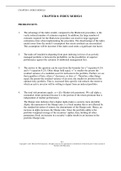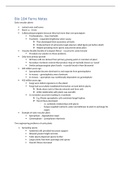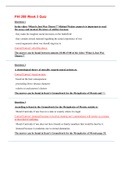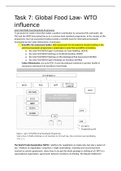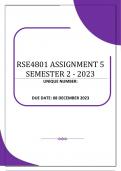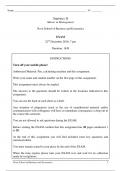CHAPTER 8: INDEX MODELS
CHAPTER 8: INDEX MODELS
PROBLEM SETS
1. The advantage of the index model, compared to the Markowitz procedure, is the
vastly reduced number of estimates required. In addition, the large number of
estimates required for the Markowitz procedure can result in large aggregate
estimation errors when implementing the procedure. The disadvantage of the index
model arises from the model’s assumption that return residuals are uncorrelated.
This assumption will be incorrect if the index used omits a significant risk factor.
2. The trade-off entailed in departing from pure indexing in favor of an actively
managed portfolio is between the probability (or the possibility) of superior
performance against the certainty of additional management fees.
3. The answer to this question can be seen from the formulas for w 0 (equation 8.24)
and w* (equation 8.25). Other things held equal, w 0 is smaller the greater the
residual variance of a candidate asset for inclusion in the portfolio. Further, we see
that regardless of beta, when w 0 decreases, so does w*. Therefore, other things
equal, the greater the residual variance of an asset, the smaller its position in the
optimal risky portfolio. That is, increased firm-specific risk reduces the extent to
which an active investor will be willing to depart from an indexed portfolio.
4. The total risk premium equals: + ( × Market risk premium). We call alpha a
nonmarket return premium because it is the portion of the return premium that is
independent of market performance.
The Sharpe ratio indicates that a higher alpha makes a security more desirable.
Alpha, the numerator of the Sharpe ratio, is a fixed number that is not affected by
the standard deviation of returns, the denominator of the Sharpe ratio. Hence, an
increase in alpha increases the Sharpe ratio. Since the portfolio alpha is the
portfolio-weighted average of the securities’ alphas, then, holding all other
parameters fixed, an increase in a security’s alpha results in an increase in the
portfolio Sharpe ratio.
8-1
Copyright © 2021 McGraw-Hill Education. All rights reserved. No reproduction or distribution without the prior written consent of
McGraw-Hill Education.
, CHAPTER 8: INDEX MODELS
5. a. To optimize this portfolio one would need:
n = 60 estimates of means
n = 60 estimates of variances
n2 − n
= 1,770 estimates of covariances
2
n 2 + 3n
Therefore, in total: = 1,890 estimates
2
b. In a single index model: ri − rf = α i + β i (r M – rf ) + e i
Equivalently, using excess returns: R i = α i + β i R M + e i
The variance of the rate of return can be decomposed into the components:
(l) The variance due to the common market factor: i2 M2
(2) The variance due to firm specific unanticipated events: σ 2 (ei )
In this model: Cov(ri , r j ) = β i β j σ
The number of parameter estimates is:
n = 60 estimates of the mean E(ri )
n = 60 estimates of the sensitivity coefficient β i
n = 60 estimates of the firm-specific variance σ2(ei )
1 estimate of the market mean E(rM )
1 estimate of the market variance M2
Therefore, in total, 182 estimates.
The single index model reduces the total number of required estimates from
1,890 to 182. In general, the number of parameter estimates is reduced from:
n 2 + 3n
to (3n + 2)
2
6. a. The standard deviation of each individual stock is given by:
σ i = [β i2 M2 + 2 (ei )]
Since βA = 0.8, βB = 1.2, σ(eA ) = 30%, σ(eB ) = 40%, and σM = 22%, we get:
σA = (0.82 × 222 + 302 )1/2 = 34.78%
σB = (1.22 × 222 + 402 )1/2 = 47.93%
8-2
Copyright © 2021 McGraw-Hill Education. All rights reserved. No reproduction or distribution without the prior written consent of
McGraw-Hill Education.
CHAPTER 8: INDEX MODELS
PROBLEM SETS
1. The advantage of the index model, compared to the Markowitz procedure, is the
vastly reduced number of estimates required. In addition, the large number of
estimates required for the Markowitz procedure can result in large aggregate
estimation errors when implementing the procedure. The disadvantage of the index
model arises from the model’s assumption that return residuals are uncorrelated.
This assumption will be incorrect if the index used omits a significant risk factor.
2. The trade-off entailed in departing from pure indexing in favor of an actively
managed portfolio is between the probability (or the possibility) of superior
performance against the certainty of additional management fees.
3. The answer to this question can be seen from the formulas for w 0 (equation 8.24)
and w* (equation 8.25). Other things held equal, w 0 is smaller the greater the
residual variance of a candidate asset for inclusion in the portfolio. Further, we see
that regardless of beta, when w 0 decreases, so does w*. Therefore, other things
equal, the greater the residual variance of an asset, the smaller its position in the
optimal risky portfolio. That is, increased firm-specific risk reduces the extent to
which an active investor will be willing to depart from an indexed portfolio.
4. The total risk premium equals: + ( × Market risk premium). We call alpha a
nonmarket return premium because it is the portion of the return premium that is
independent of market performance.
The Sharpe ratio indicates that a higher alpha makes a security more desirable.
Alpha, the numerator of the Sharpe ratio, is a fixed number that is not affected by
the standard deviation of returns, the denominator of the Sharpe ratio. Hence, an
increase in alpha increases the Sharpe ratio. Since the portfolio alpha is the
portfolio-weighted average of the securities’ alphas, then, holding all other
parameters fixed, an increase in a security’s alpha results in an increase in the
portfolio Sharpe ratio.
8-1
Copyright © 2021 McGraw-Hill Education. All rights reserved. No reproduction or distribution without the prior written consent of
McGraw-Hill Education.
, CHAPTER 8: INDEX MODELS
5. a. To optimize this portfolio one would need:
n = 60 estimates of means
n = 60 estimates of variances
n2 − n
= 1,770 estimates of covariances
2
n 2 + 3n
Therefore, in total: = 1,890 estimates
2
b. In a single index model: ri − rf = α i + β i (r M – rf ) + e i
Equivalently, using excess returns: R i = α i + β i R M + e i
The variance of the rate of return can be decomposed into the components:
(l) The variance due to the common market factor: i2 M2
(2) The variance due to firm specific unanticipated events: σ 2 (ei )
In this model: Cov(ri , r j ) = β i β j σ
The number of parameter estimates is:
n = 60 estimates of the mean E(ri )
n = 60 estimates of the sensitivity coefficient β i
n = 60 estimates of the firm-specific variance σ2(ei )
1 estimate of the market mean E(rM )
1 estimate of the market variance M2
Therefore, in total, 182 estimates.
The single index model reduces the total number of required estimates from
1,890 to 182. In general, the number of parameter estimates is reduced from:
n 2 + 3n
to (3n + 2)
2
6. a. The standard deviation of each individual stock is given by:
σ i = [β i2 M2 + 2 (ei )]
Since βA = 0.8, βB = 1.2, σ(eA ) = 30%, σ(eB ) = 40%, and σM = 22%, we get:
σA = (0.82 × 222 + 302 )1/2 = 34.78%
σB = (1.22 × 222 + 402 )1/2 = 47.93%
8-2
Copyright © 2021 McGraw-Hill Education. All rights reserved. No reproduction or distribution without the prior written consent of
McGraw-Hill Education.

